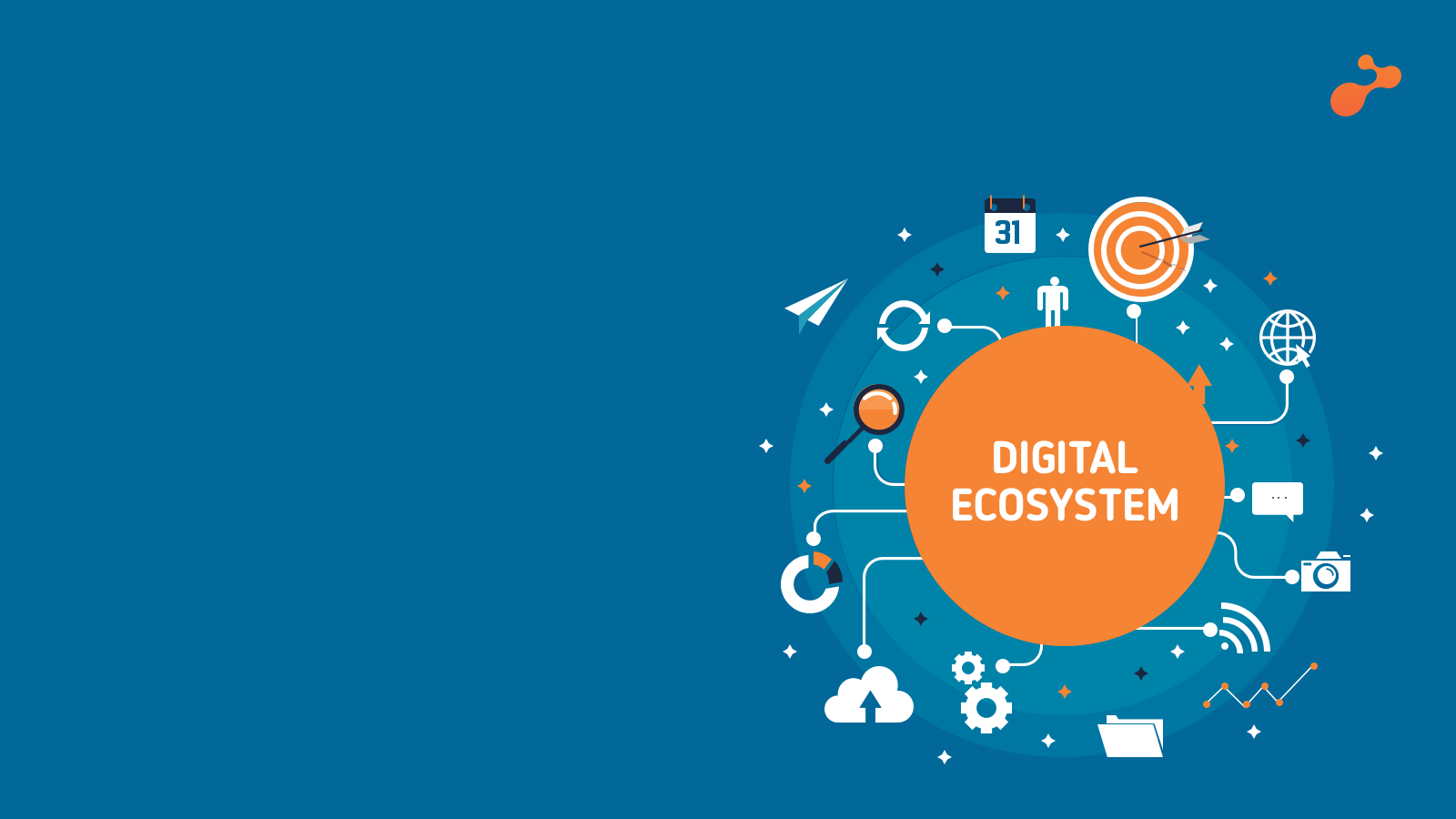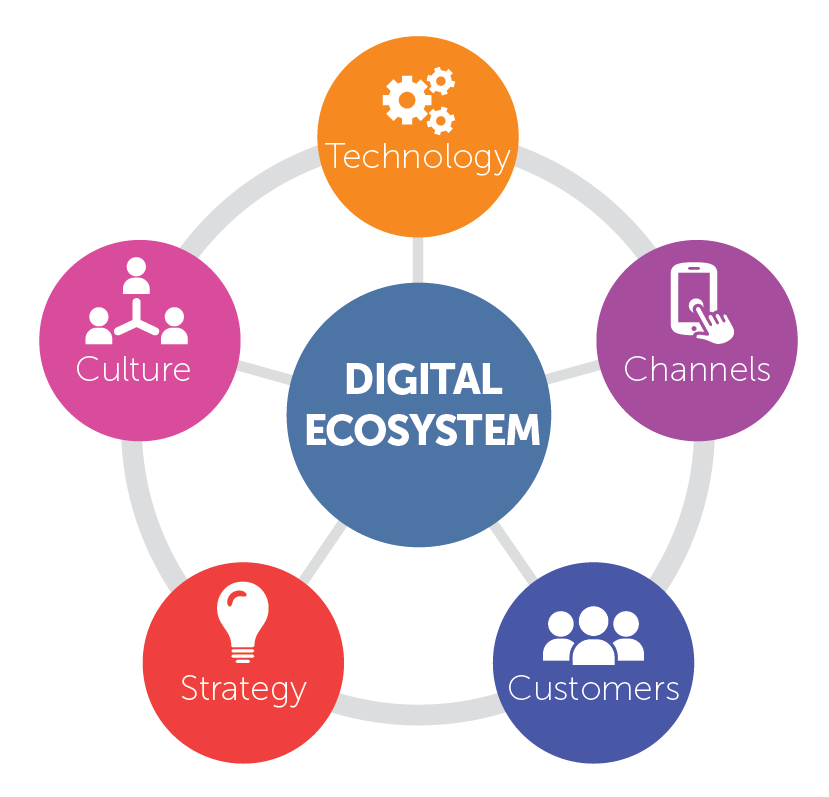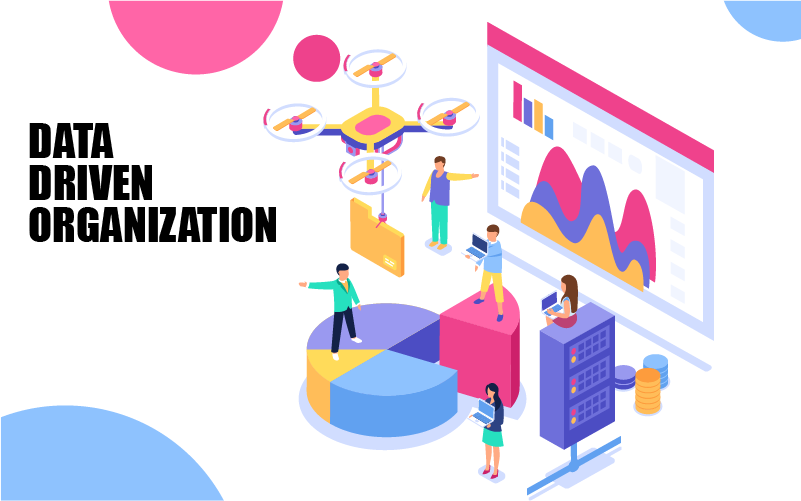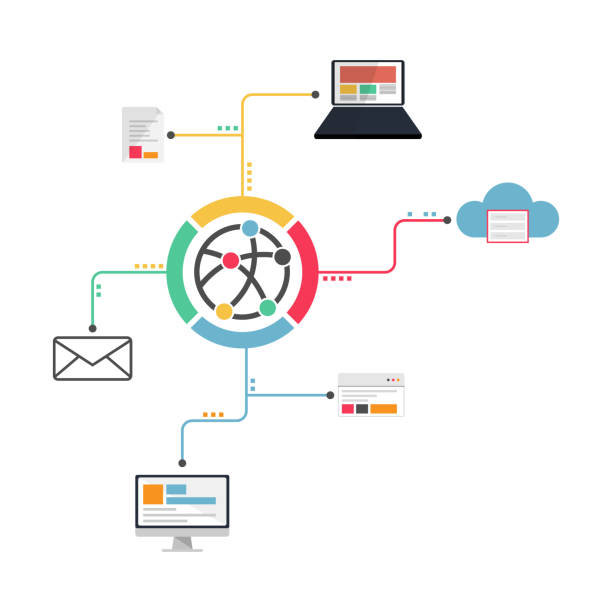A Guide to building a digital ecosystem
A digital ecosystem enables an organization to cut costs, be more agile, and create products faster. Businesses recognize the advantages of digital ecosystems, which allow them to collaborate internally, connect with other companies, and share resources and expertise. Therefore, more than 80% of companies today leverage digital ecosystems by achieving digital innovation and digital transformation.
Budget, time, and product quality are essential but are only partial factors to success. In today’s business environment, it’s often just as important to have a good network of connections as it is to build a great product.
Even if a company is not a world leader in a field, partnering with one or two other companies can help drastically increase brand reach, customer base, and resource access. Some examples of resources that would be available include software infrastructure and other support tools.
Digital ecosystems constitute different services that work together so that companies can meet various user needs in one go. Today’s most extensive and successful digital ecosystems were launched by tech companies that used hyperscale platforms to outdo traditional competitors. By controlling customer interfaces and control points like advertising, search, and messaging, these tech companies were able to take business away from their traditional rivals.
Many benefits come along with having a digital ecosystem as opposed to sticking with a more conventional system. Even though taking the first step can be daunting, it’s not nearly as difficult as one might think to get the process of building a digital ecosystem underway.
Here we discuss what digital ecosystems are, the characteristics of digital ecosystems, and how leaders can build such ecosystems for their companies.
What is a digital ecosystem?
A digital ecosystem is a network of products or companies that are interconnected. In digital ecosystems, two or more companies usually collaborate to offer a wide range of products and services. Some digital ecosystems also consist of a single company creating an ecosystem of several connected products that work together to provide a suite of services.
Interoperability is essential to creating an effective digital ecosystem. Most businesses use digital technology as part of their operations, but these tools are often siloed, lack integration, and require manual intervention. Companies must consider how these technologies interact and promote collaboration where possible to take full advantage of digital technology.
The values of the digital ecosystem
Value for the end consumer is created in a digital ecosystem by platforms enabling others; such as in an ecosystem where software developers create value for platform owners by helping them to create various products, and the platform owners reward them with incentives. Incentives keep everyone involved in the ecosystem because people and organizations benefit from interacting within it. This way, value is mutually created for the platform owner, end customer, and ecosystem participants.
Additionally, it is becoming increasingly easier for independent parties to communicate and transact with each other in today’s digital world. The ease has led to a reduction in transaction costs, and as a result, it is often more desirable to “buy” from others rather than “make” something in-house. Moreover, this is also more feasible to keep up with the rapid pace of innovation enabled by digital technologies.
The digital world is ever-changing, and with that comes a shift in how we view value chains. Value chains are now becoming less important as digital ecosystems take over. It’s important to note that ecosystems are more than just a group of business partners. Ecosystems are a network of people who rely on each other to create something of value. It means that everyone in the ecosystem has the same goal and that one person’s success depends on the ecosystem’s success as a whole.
Not being a part of digital ecosystems or not having an ecosystem strategy could result in a company being left behind. Digital ecosystems are constantly growing and advancing, so those outside of them may have difficulty competing. In addition, ecosystems usually expand past their original limits. Therefore, new market entry is likely to happen through a whole ecosystem instead of just one individual innovator.
Characteristics of a digital ecosystem
Traditional strategy thinking can often delay decisions because of command and control methodology, established metrics, or various layers of decision-making.
On the other hand, digital ecosystems allow a company to play with other stakeholders in a decentralized network by giving up some control. This dynamic environment rewards resiliency, sensing changes in rapidly shifting markets, and responding quickly.
A company adopting an ecosystem mindset adds value in new ways to a broader range of stakeholders instead of simply focusing on linear relationships with suppliers, customers, and distributors. Furthermore, we examine the characteristics of a digital ecosystem.
Customer-Centric
Personalized advertising and marketing are not the only aspects of customer centricity. The scale of a business makes it possible to provide a full spectrum of customer service. The customer journey needs to be integrated using cross-department, cross-product, and cross-service collaboration.
For instance, Amazon, for instance, demonstrates a strict focus on creating value that has led to its success as a digital ecosystem. Like Amazon, companies don’t always monetize ecosystems. Instead, they focus on understanding the customer before pricing products and services.
Automated Systems
Customer, supplier, and third-party insights provide digital ecosystems with a wealth of information companies can utilize to meet business objectives. Manually working with the data can get tricky and tedious. Moreover, there is a potential for error. Also, certain tasks require repetitive actions. Automation can cut down on costs, work accurately and efficiently, and once an automated system is established, only minimal maintenance is required.
Automating, cloud computing, applications, and B2B integration platforms control big data platforms. Dynamic and intelligent responses to market disruptions require companies to develop automated processes. Adding new services and products to increase value and lower prices are key automation elements.
Data Driven
A digital ecosystem enables businesses to collect further information about processes, customers, transactions, and more. Data drives every digital ecosystem. Through business analytics, companies can develop strategies and data-driven ecosystems to transform their abilities and unlock actionable insights.
Implementing data-driven strategies is crucial to engage and teach the entire company to work towards a shared objective, become data-literate, and encourage more senior leaders to be active participants. The better we understand our customers, the better we will be able to offer them services, software, and technology that will improve their customer experience.
Dynamic Systems
Digital ecosystems replace segmented and siloed departments in traditional business structures by offering a collaborative and dynamic environment. Collaboration at every level of the organization helps eliminate conventional hierarchy and helps identify new business models, innovative technology, and new markets. Analytical methods, new technologies, and newer ways of leveraging innovation in a digital ecosystem allow for new insights and scalability.
Global Collaboration
Many global companies are already generating revenue from digital ecosystem business models due to their potential to grow core businesses, expand networks, and expand portfolios. Companies must also work towards global systems so that the systems are accessible worldwide. The greater the accessibility of the system, the greater the benefits to the company and the global community. Companies must build digital ecosystems to facilitate collaborative tasks across countries, geographies, and languages.
Challenges with creating a brand digital ecosystem
In an industry-centric view, companies will be far less able to recognize the different types of customers, competitors, and business partners they need to interact with as their sector moves online. Even if companies do recognize them, it’s often too late. Building a digital ecosystem includes many barriers and challenges to overcome. It involves:
- The long-established culture within an organization.
- Management and resource shortages in IT.
- Budget clarity for digital transformation
- Securing digital data.
Common types of digital ecosystems for brands
There are three types of digital ecosystems classified based on size and capacity to grow:
Functional Digital Ecosystem
Smart and connected products are a good fit for organizations looking to improve their current products. In a functional ecosystem, business partners work together to digitize an existing product while simultaneously keeping management complexity low. This ecosystem usually has 10 to 100 existing partners across the industries. Data collection and integration are difficult because the ecosystems are mostly closed, so there are limitations.
For instance, automobile manufacturers need to connect cars to the digital services provided by their partners to create a product-centric ecosystem for an intelligent, connected vehicle. However, these services are usually limited to a limited number of products.
Platform Ecosystem
An ecosystem based on platforms is more advanced than an ecosystem based on digitizers. A key focus of its services is providing high-quality service and limiting obstacles while seamlessly connecting users and smart devices on a platform.
A significant aspect of this digital platform ecosystem is its data-driven approach to leveraging customer insights for upselling or creating new offerings. The platform ecosystem generates revenue through usage. Millions of partners can be involved in platform ecosystems and a wide range of digital services.
The Xiaomi ecosystem includes smartphones, laptops, fitness, and mobile apps – it is considered a platform ecosystem. Xiaomi’s contributors, and the device manufacturers, shared the platform to create intelligent connected devices.
Super Platform ecosystem
Among all the types of digital ecosystems, super platform ecosystems are the most complex. Super platform ecosystems integrate into one integrated service, and the integrated platform captures user data. This ecosystem also converts data from users into money through adjacent business models. There are at least 10 million partners in the super-platform ecosystem across global industries. Apple, Google, Amazon, Tencent, and other tech giants control the majority of Super Platform Ecosystems.
Amazon Alexa is an example of a super platform ecosystem that combines shopping, payments, transportation, and communication services.
Smart speakers have a functional ecosystem that improves their hardware and voice recognition capabilities. For example, a platform ecosystem that allows Alexa to add skills and applications enables her to offer more services. A super platform ecosystem is used to connect all the platforms.
Are digital ecosystems for large companies?
Even though digital ecosystems may only cater to major corporations and big enterprises, small and medium enterprises can also take advantage of digital ecosystems. Investing in digital procedures is easier if a company has more resources available. However, that doesn’t imply that smaller businesses can’t adopt it. Digital procedures must be considered an interrelated system, and companies must promote teamwork integration between applications to bring numerous benefits and advanced digitalization throughout the business.
A digital ecosystem can be a great asset for an SME business. A business can enjoy enhanced efficiency, scalability, and self-sufficiency with the right technology. All this, in turn, can lead to cost savings and growth. Additionally, a digital ecosystem can help a company stay competitive in an increasingly digital world.
Building a brand’s digital ecosystem
Collaboration and interaction are integral to building a digital ecosystem. Building a digital ecosystem is not meant to start from scratch, but it’s about improving productivity and reducing errors, or manual processes spent on inefficient processes. A self-reflective assessment of how a business operates allows the company to build a digital ecosystem that truly serves the business, employees, and customers.
The following elements are key to creating a successful digital ecosystem:
Establish collaboration and drive innovation.
A collaborative culture is imperative to developing the digital ecosystem. Collaboration at every level of an organization helps eliminate conventional hierarchy and helps identify new business models, innovative technology, and new markets. For instance, GitHub, an online community for millions of software developers, is a platform that accelerates innovation and learning through collaboration.
Together, software developers can find solutions much faster than in isolation. The development of better software is beneficial to developers, organizations, and also customers.
Implement the Right Digital Technologies
A company must invest in both core and emerging technologies to build a digital ecosystem. As far as technology investments go, cloud services, analytics, management, and security are considered the biggest.
Modernizing core technology and preparing an enterprise for the future requires a differentiated approach. Modern businesses are better prepared for challenges by investing in creating a digital ecosystem. In the long run, consumers will only benefit from collaboration between members of an ecosystem.
Implement Agile Principles
Agile practices can no longer keep a company ahead; these practices only allow it to keep up with the competition. Managers must ensure that organizations can pivot quickly whenever market shifts occur. The company will have to drop or switch partnerships if things get tough. Maintaining a digital ecosystem as partners and suppliers change and as customer needs evolve is imperative.
Focus on API Integrations
The API integration can help achieve communication and integration, which are necessary for a successful digital ecosystem. The capabilities of existing software solutions’ integration can be maximized by using APIs and connectors, automating more processes.
Implement Automation
Automation is a key component of big data platforms, cloud computing, applications, and B2B integration platforms. Automated processes are necessary for companies to respond to market disruptions dynamically and intelligently. Developing a system to implement automated processes is crucial, eliminating inefficient manual steps and saving employees time.
Use data for decision-making.
Implementing a data-driven strategy is crucial to engaging and training the entire organization to become data-literate, working towards a common goal, and encouraging more leaders to be active participants. The better a company understands its customers, the better it will be able to offer its services, software, and technology to improve the overall service experience.
Examples of brands that have built good digital ecosystems
There are multiple examples of digital ecosystems in numerous industries, from online shopping to banking and digital payments, voice assistants, autos, housing, healthcare, and more. Unlike traditional relationships between a client and customer or private business networks, every company participating in a digital ecosystem has something to share or gain from the other companies. This creates a unique opportunity for businesses to collaborate and thrive in the digital age.
Below, we discuss how large digital ecosystems have been built by companies such as Amazon, Apple, Microsoft, and Alibaba:
Amazon
Amazon’s online retail business relies on strong technology infrastructure. Amazon has expanded beyond retail and rented its computing centers to other companies. This segment of Amazon’s business is called Amazon Web Services (AWS).
AWS is one of Amazon’s hubs for orchestrating its digital ecosystem. Several companies, including Netflix, Capital One, and 3M, rely on AWS to support their digital operations. For its Prime members, Amazon has integrated acquisitions like grocery chain Whole Foods to create a new customer channel. Besides retailing, it offers IT services, media, and more through its digital ecosystem.
Platforms such as Amazon are shaping future ecosystems. Executives must rethink traditional business models to establish a new platform and connect to ecosystems. Business executives need a whole new attitude toward such ecosystems. The purpose of ecosystem participants must go beyond maximizing profits. Innovation and value delivery are accelerated as a result of these efforts.
Apple
People don’t know what they want until you show it to them. Steve Jobs
Apple has over one hundred subsidiaries and operates in most countries. Apple’s elements such as App Store Connect, Apple Pay, CardPay, Face ID, Touch ID, GameKit, Apple TV+, Apple Arcade, iCloud, Apple News+, Apple Fitness+, App Store Connect, Apple Pay, Apple News+, and Apple Arcade create a value stream loop that defines Apple’s ecosystem business model. The model focuses on developing mechanisms that create, deliver, and capture value within an ecosystem. To limit external participation, pricing, authorizations, and standards are used.
Microsoft
The five central pillars of the Microsoft stack constitute Microsoft’s ecosystem. The five pillars include productivity, Dynamics 365 Business App, Azure, Data & Analytics, and Purpose Build App. Microsoft’s cloud-based business applications platform integrates CRM, ERP, productivity applications, and artificial intelligence into one platform. The Common Data Service lays the foundation for all of these pillars.
The Microsoft Ecosystem assists in digital transformation by enabling enterprise-wide innovation through technology. Pushing into the intelligent cloud helps the change extend to every aspect of the organization. Employees can accomplish more in a productive workspace. High-quality digital services can be built on scalable platforms by optimizing operations and engaging with customers to provide even greater value.
Alibaba
Alibaba connects buyers and sellers of goods. With the advancement of technology, more business functions have moved online. The operations included established ones, like advertising, marketing, logistics, and finance, and emerging ones, like affiliate marketing, product recommendations, and influencer marketing.
The Alibaba ecosystem was expanded to accommodate these innovations, which enabled new types of online businesses to be created, completely transforming China’s retail industry as a result.
Traditional industries do not manage ecosystems efficiently or as efficiently as these ecosystems. Alibaba is no longer just an online commerce company. Besides e-commerce and financial services, Alibaba does exactly what eBay, Amazon, PayPal, FedEx, Google, and wholesalers, including a significant portion of manufacturers, do in the US.
Achieving brand digital transformation with a digital ecosystem
When creating a digital ecosystem from scratch, a company opens up a new world of possibilities. Budget and time can often stand in the way of implementing new technology in a company. However, many businesses don’t realize that plenty of other companies are also trying to digitize and modernize at the same time. Forming partnerships with other companies can jump-start a company’s digital transformation.
By building a digital ecosystem, a company gets access to customer analytics and data that would otherwise be very time-consuming and expensive to try and obtain. In addition, a company can also take advantage of new digital features or products that its partners may have already developed.



















